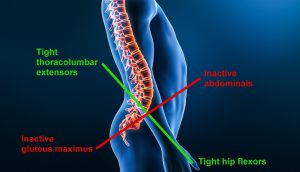What is lower cross syndrome?
Lower cross syndrome
Lower crossed syndrome (LCS), also known as pelvic crossed syndrome or distal crossed syndrome, is a postural imbalance characterized by muscle tightness and weakness in specific areas of the body. It primarily affects the muscles of the pelvis, hips, and lower back.


In LCS, there is a pattern of muscle imbalance between the muscles in the front and back of the body, as well as between those on the left and right sides. This imbalance can lead to altered movement patterns, chronic pain, and increased risk of injury.
Symptoms
The symptoms of lower crossed syndrome can vary depending on the severity of muscle imbalances and individual factors. Common symptoms may include:
- Lower Back Pain: Chronic or intermittent pain in the lower back, especially around the lumbar spine, which may worsen with prolonged sitting or standing.
- Hip Pain or Discomfort: Pain or discomfort in the hips, particularly in the front of the hips (anterior hip pain) or along the sides of the hips.
- Pelvic Tilt: An anterior pelvic tilt, where the pelvis tilts forward, resulting in an exaggerated arch in the lower back (hyperlordosis) and a protruding abdomen.
- Muscle Tightness: Tightness or stiffness in the hip flexors, particularly the iliopsoas and rectus femoris muscles, which can contribute to decreased hip mobility and range of motion.
- Weakness or Fatigue: Weakness or fatigue in the gluteal muscles (gluteus maximus and gluteus medius) and abdominal muscles, which may affect stability, balance, and overall movement patterns.
- Postural Changes: Observable postural changes, such as a forward-leaning posture, excessive arching of the lower back, or a protruding abdomen.
- Numbness or Tingling: In some cases, nerve compression or irritation resulting from muscle imbalances and postural abnormalities may lead to sensations of numbness, tingling, or weakness in the lower back, hips, or legs.
Causes
Lower cross syndrome can develop due to a variety of factors, including:
- Pelvis and spinal misalignment: Inadequate ergonomics and injuries to the pelvis and spine can contribute to misalignment of the pelvic joints and spine. This misalignment can disrupt the normal spinal curvature, leading to conditions such as anterior pelvic tilt and loss of the kyphotic curve. Additionally, the irritation of nerves that supply the muscles can result in muscle imbalances.
- Sedentary Lifestyle: Prolonged sitting or inactive behaviors can lead to muscle imbalances and tightness, particularly in the hip flexors and lower back muscles.
- Poor posture: habitual poor posture, such as slouching or excessive arching of the lower back, can place uneven stress on the muscles of the pelvis and lower back, leading to pelvis and spinal misalignment over time.
- Biomechanical Factors: Structural abnormalities or imbalances in the skeletal system, such as leg length discrepancies or foot pronation (flat feet), can alter the alignment of the pelvis and contribute to lower crossed syndrome.
Conclusion
In conclusion, addressing the underlying causes of lower crossed syndrome often involves a multifaceted approach that includes corrective exercises, lifestyle modifications, ergonomic adjustments, and sometimes professional intervention such as physical therapy or chiropractic care. Identifying and addressing contributing factors can help prevent the progression of lower crossed syndrome and reduce the risk of associated pain and dysfunction.
